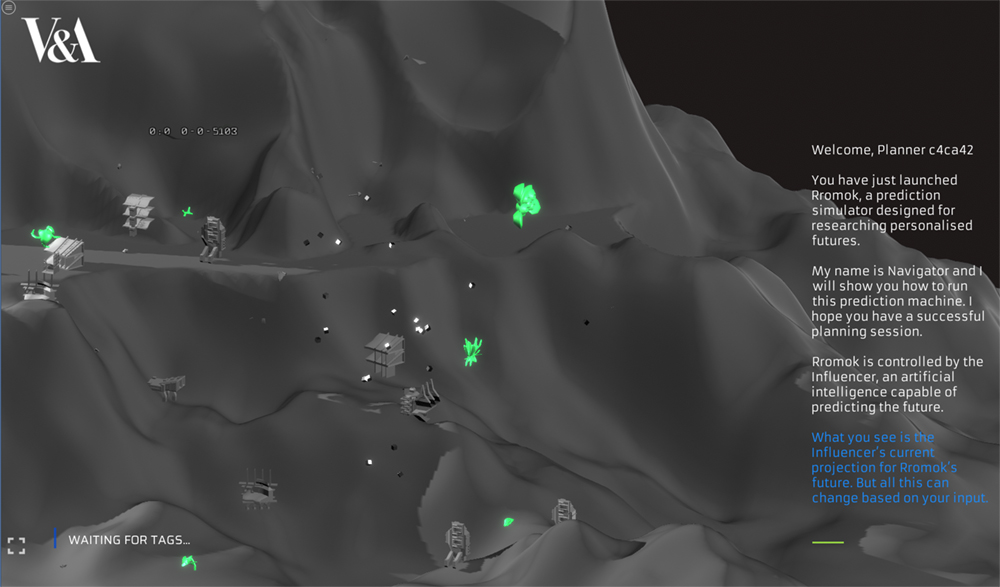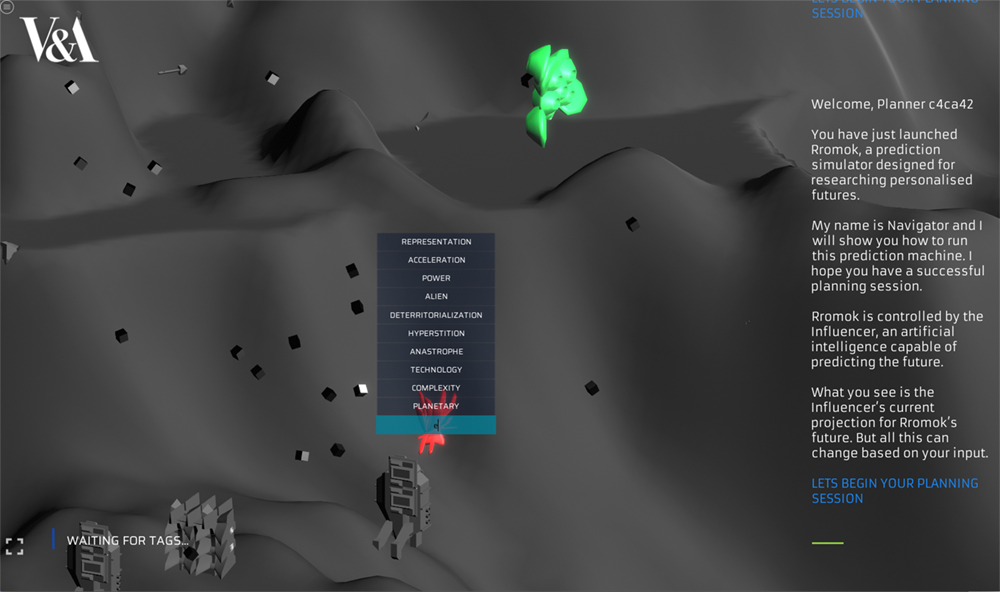Rromok is a simulation game, viewed through the lens of an artificial intelligence, that was developed by the design collective Rites Network and commissioned by the V&A.
We caught up with Jelena Viskovic, one of the six members who make up the collective, to find out a little bit about her, the collective and exactly what Rromok is.
What does Rromok mean? What do gamers get from exploring this world?
Rromok is an abstraction of the Hungarian word for ‘ruins’. The title describes a world which is not easy to access. It isn’t necessarily there for the player, but players can contribute to it, and indirectly shape it with their input. The game was originally about creating a sandbox city-state that exists independent of human factors. We were looking for ways to model branching in game narratives and mechanics that influence the governance of a sandbox world and it’s regions. We were inspired by the myth of Osiris, god of the underworld, whose body parts were scattered across the Nile and put together by the goddess Isis, to symbolically reunite the region and its god, converting chaos into order. This inspired us to create an assembly game where the player has to find parts of a mechanism in order to make the simulation work and regulate itself. The question we also pose is what does this self-regulated world get out of the players? Players can help this world and its algorithmic infrastructure process data scraped from social media platforms, which helps Rromok predict its own future. The players in exchange get something like a satellite view of themselves. We live in a world where we constantly see ourselves from an abstract view in navigation apps, maps, quantified self movements and we are obsessed with surveillance. We seem to be engaged in a birds-eye view of ourselves and the algorithmic mechanisms we indirectly influence and are influenced by. We have so many ideas about how to control the future and what it holds for us and so many platforms to talk about them, but we might just be dabbling in the unknown. Through this game we are testing the role of the players agency in the artificial world of Rromok and how willing they are to contribute to a world that exists for its own purpose and not the players, regardless of all the feedback that it gives to the player.

You studied Photography at Moholy-Nagy in Hungary, did Design Interactions at the Royal College and then moved to Moscow to do the New Normal interdisciplinary programme at Strelka Institute. You’re a game designer – how has your education in art and design shaped your work?
I am an artist but also a game designer; the distinction is made by the different institutions that are interested in my work. I’m interested in complex technological systems, and I find that simulation and game design techniques can be very useful tools to engage with these systems. I’m also interested in reshaping what we see as technology, for example working with social organisational strategies and things like religion, myth and narrative as technology. I try to adjust my profession as an artist to emphasise a more technical role. This enables me to access new immersive technologies and content that I am interested in and at the same time critical of. I study a lot and am sometimes inspired by the experience of working in the tech industry and the challenges that go together with this type of work. In my independent work and in the work that Rites Network collaboratively produces, the aim is to try to figure out how technology works and what are the generative aspects of it, and then try to model and reproduce this in engaging and unusual ways that reveal things that are hidden in the background of our reality, even though we are impacted by them in our everyday lives.

Can you tell us about the collective Rites Network that you work with? Who else is on the team and how do you work together?
We are a network of people with very diverse backgrounds in art, sound, writing, industrial design and economics. We started working together in Budapest in 2012. There are six of us in the collective currently, with five of who created Rromok: Tamás Páll, András Molnár, Tamás Marquetant, Iván Rohonyi Demkó, and myself. Márton Tóth is our 6th memeber and Qiao Lin is a web developer and artist who worked with us on Rromok. We developed a series of interconnected projects in the past. The first of them is called Rites, it was our first project and we envisioned it by randomly browsing through YouTube content back in 2012. It’s a procedural, generative world and exploration game that recycles some of the social media and YouTube content we were fascinated by in virtual reality. Players can find and assemble social media content and memories they feel they relate to. At this time we were all living in Budapest and were working on our independent projects in different fields at the same time. Since then, after participating in various exhibitions and a start-up incubator in Budapest, many members have moved away to other countries in the EU. I went to do a masters degree in Design Interactions in London and then moved to Moscow for a programme at the Strelka Institute. Recently, half of the members of the group moved to Berlin and we started working together frequently and sharing ideas and knowledge. This remoteness, the experience of the individual members of the collective – the chaotic urban aesthetics and tropes we portray, and how we talk about social media and digital infrastructure in our projects, these have always influenced the way we work together. Rites Network is a newer name for the group and a project that we started as a platform for the collective to gather together and perform our work as a live gameplay and sound performance. The idea of Rromok rose out of one of these performances.


